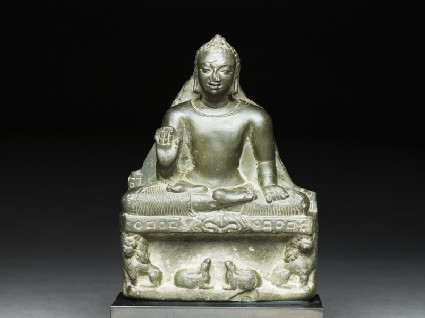Room 32 | India 600-1900 gallery
Explore Hindu, Buddhist and Jain art from India, the Himalayas and Southeast Asia.

Galleries : 299 objects
- Reference URL
Actions
Seated figure of the Buddha
-
Details
- Associated place
- Date
-
5th - 6th century AD (AD 401 - 600)
Licchavi Period (c. AD 380 - c. 880)
- Associated people
-
the Buddha (active c. 560 BC - c. 486 BC) (subject)
- Material and technique
- stone
- Dimensions
-
with mount 23 x 15.9 x 5.6 cm max. (height x width x depth)
19 x 14 x 4.5 cm max. (height x width x depth)
- Material index
- Technique index
- Object type index
- No. of items
- 1
- Credit line
- Purchased, 1996.
- Accession no.
- EA1996.1
-
Further reading
Heller, Amy, Early Himalayan Art (Oxford: Ashmolean Museum, 2008), no. 1 on p. 42, pp. 19 & 20, illus. p. 43
Location
Objects are sometimes moved to a different location. Our object location data is usually updated on a monthly basis. Contact the Jameel Study Centre if you are planning to visit the museum to see a particular object on display, or would like to arrange an appointment to see an object in our reserve collections.
Publications online
-

Early Himalayan Art
This Buddha image represents the pure Nepalese style of the Licchavi period under the influence of Gupta India. The heavy shoulders and broad chest are voluminous, yet without any sense of muscularity [1]. The massive torso and the full face with its warm expression convey an impression of serenity and the cessation of movement. The ovoid face has slightly open, bow-shaped lips, rounded cheeks, and a high hairline; the nose is now broken. The curls of the hair are raised, not incised, and the ushnisha is low-domed. The neck is relatively long. The samghati (robe) which clings to the Buddha’s body is indicated only by incised lines showing its round collar, a small fold of fabric flung over the shoulder towards his back and the narrow stripes formed by the thin folds of light fabric draped over his legs [2].
The Buddha is seated in the lotus position, with the soles of his well-fleshed feet turned upwards. His right hand is in abhaya mudra or the gesture of protection. The left hand is held palm upward in the varada mudra of generosity; the ends of the extended fingers are now broken off. The throne-supporting lions are shown in profile with voluminous manes, while the two gazelles raise their heads to the empty central space representing the Wheel of the Law, a treatment which recalls the base of the shrine of Tukan-Bahal in Kathmandu [3]. It is also possible, however, that the gazelles are turning their heads to hear the Buddha as he preaches the sermon in the deer park at Sarnath.
Originally the image would have had a prabha (surround) with geometric marks similar to the alternating circles and squares which decorate the front of the throne. A single letter incised on the back near the upper shoulder is apparently a later addition [4].
[Footnotes]
1 Similar torso and body proportions are seen in the Kathmandu image of a seated Brahma, illus. in Pal, The Arts of Nepal, vol. 1, pl. 11, and dated to 500-50 ad. In Sikubahi, Patan, the stone sculpture of Uma-Mahesvara (length 65 cm), dated 537 ad by inscription, is far more broad and massive (Pal, op. cit., pl. 9; but date according to the UNESCO project: Bangdel, A Report on the Study of the Iconography of Kathmandu Valley and their Preservation and Protection, p. 84.)
2 This emphasis on the raised collar of the samghati is typical of this period in Nepal: see e.g. the seated stone Buddha dated to the sixth century in Pal, op. cit., pl. 181, also Béguin and Held, Népal: Vision d’un art sacré, pls. 131-2, and the standing stone Buddha at Pashupatinath (see Introduction).
3 Slusser, Nepal Mandala, pl. 224, and Pal, op. cit., pl. 182.
4 I thank Dr Gautam Vajracharya for his opinion that this syllable is ra and was probably carved around the sixteenth century or even later; it does not conform to the epigraphy of the Licchavi period.
Galleries
Notice
Objects may have since been removed or replaced from a gallery. Click into an individual object record to confirm whether or not an object is currently on display. Our object location data is usually updated on a monthly basis, so contact the Jameel Study Centre if you are planning to visit the museum to see a particular Eastern Art object.
© 2013 University of Oxford - Ashmolean Museum







